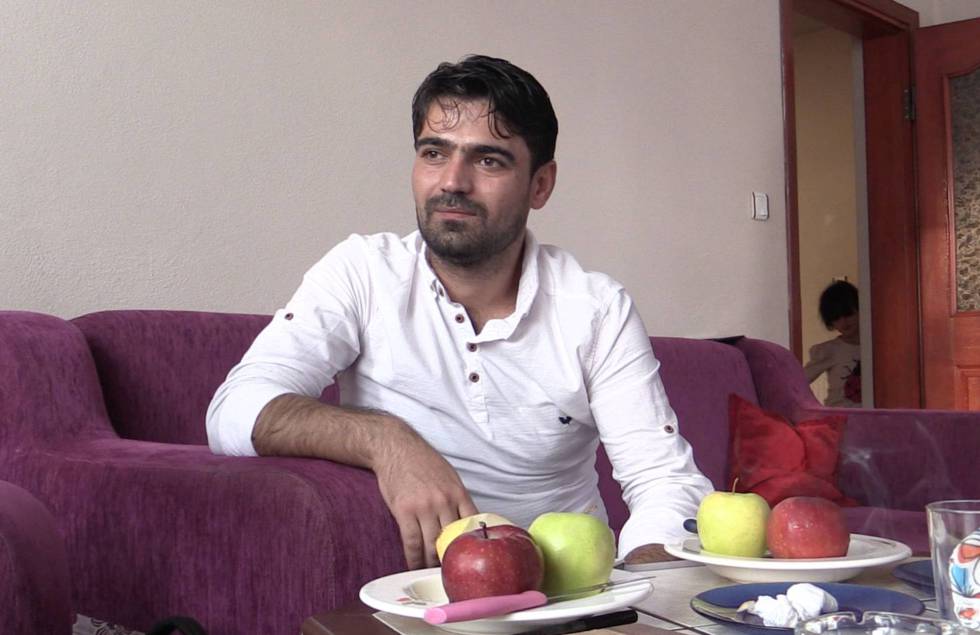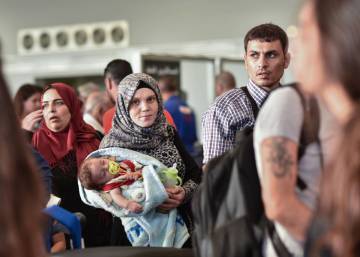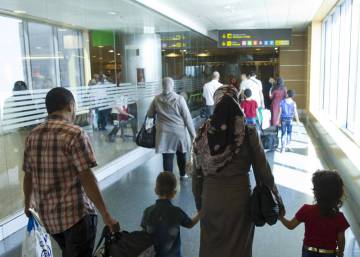REFUGEE CRISIS
Syrian refugees begin the journey back home
More than 31,000 people returned to Syria during the first half of 2017, many of them from Turkey
Kocaeli

Syrian carpenter Rafat Rayub at his house in Turkey. PILAR CEBRIÁN
“It was like being born again. I stopped feeling like a stranger, I was finally home again.” Rafat Rayub is a carpenter who visited his home town of Radua, in northern Syria, for the first time since he left the country to escape the war. He is now living as a refugee in the Kocaeli district of Turkey, near Istanbul.
Last September, during the Muslim sacrifice feast of Eid el-Adha, and after obtaining a permit from the Turkish authorities, Rayub enjoyed five weeks back home with his family, in a village in the Syrian province of Idlib. “I can breathe again… Those were days of gatherings, meals and happiness. At times it felt like the days before the war,” he explains.
Turkey opened its borders with Syria for the biggest Muslim celebration, allowing the temporary return of thousands of Syrian refugees living in its territory. The immigration department launched a digital platform to handle applications after setting a ceiling on the number of authorizations. In just 15 days, 53,798 people crossed into Syria through the Oncupinar access point (in Kilis province), according to data provided by the Turkish agency DHA.
It was like being born again. I stopped feeling like a stranger, I was finally home againRAFAT RAYUB, A REFUGEE WHO RETURNED TO SYRIA
“I did not hear any fighter planes or bombing for a month and a half,” said Rayub about his stay. The partial ceasefire negotiated in Kazakhstan by Turkey, Russia and Iran allowed thousands of Syrians to enjoy relative calm during the Sacrifice Feast.
Improved safety in their home country has made many Syrians decide to stay for good. In fact, at the end of the established holiday period, about 11% of those who visited their home towns (more than 6,000 refugees) did not return to Turkey.
With three million Syrian refugees, the Eurasian country is the main destination for the displaced people from the war that began in 2011. The remaining refugees are distributed mainly in Lebanon (one million), Jordan (600,000), Iraq (240,000) and Europe.
Some of the reasons why people chose to return home include a lack of job opportunities, the high cost of living, and the distance from their families. “My life here is miserable,” says Rayub, who works as a carpenter and supports his wife and four daughters on a salary of €367 a month, working 11 hours a day at an illegal job. He believes that his lifestyle in Radhua, despite the lack of stability, will be more sensible. “The cost of living is lower there, we have a property, and we would rely on family support.”
However, the process of leaving Turkey is not reversible, and people who try come back will face a permanent closure of borders. Before crossing into Syria, Turkish authorities confiscate credentials at checkpoints, including residency permits and social welfare documents.

The returning refugees
Efforts by several powers to end the Syrian war encouraged thousands of refugees to leave their lives in exile. In the first half of 2017, more than 31,000 Syrians returned from bordering countries according to the United Nations High Commissioner for Refugees. About 65% came from Turkey, totaling 20,314 people. During the Kazakhstan negotiations, four return routes were created for people looking to move back.
One of the main destinations for people returning to in Syria is a security area protected by Turkey, between Yarabulus, al-Bab and Azaz,where Turkish agencies have invested in reconstructing infrastructure, housing, schools and health services.
Nobody wants to be a refugee their whole lifeMAHMUD ASWAD, MEMBER OF SEMA
By August, 70,000 Syrians – some who had left their homes but not the country, and others who crossed the border back into Syria – had already flocked to these towns liberated from the Islamic State (ISIS). People have also gone to Idlib, the last stronghold of the Syrian opposition and Salafist factions, and other villages in the provinces of Aleppo, Homs and Hama.
“Nobody wants to be a refugee their whole life,” asserts Mahmud Aswad, a member of the Syrian Expatriate Medical Association (SEMA), which manages health assistance in the northern opposition-controlled zone. “There are also those who go back to areas controlled by the regime – such as Aleppo – because they are tired of living in another country. They would rather accept [Bashar] el Assad’s command, whom they ran from during the war, in return for getting stability back.”
End of opposition control?
Demilitarized zones were agreed upon in September and established with Assad’s chief backers, including Iran and Russia. The Syrian political opposition fears that Turkey will give in to their conditions and put an end to the last of the areas run by the opposition militias, in Idlib.
In August, 70,000 Syrians had already returned to these towns liberated from ISIS
It was there that the Turkish army deployed its soldiers at the beginning of October in order to guarantee the ceasefire. “That was the only way to stop both Russian and Iranian troops from advancing into Idlib,” maintains Naser al-Hariri, leader of the High Negotiation Committee (HNC), who has since lost his influence.
“Host countries have a duty not to forcibly send refugees back to Syria, where their lives or freedom could be in danger,” according to an Amnesty International statement. After more than six years at war, the peace process is presenting opportunities to deal with a conflict that has already caused an international crisis and come at a high price to neighboring countries.
AN ELPAIS.CAT PROJECT
Since November 2016, the Catalan edition of EL PAÍS, Elpais.cat, has been publishing a selection of news stories in English.
The texts are prepared by journalism students at the Pompeu Fabra University (UPF), who adapt content from EL PAÍS, adding extra information and explanation to these stories so that they can be understood in a global context.
This article was translated by Ruth Pérez and David Riol, and edited by the team at El País English Edition.









































No hay comentarios:
Publicar un comentario